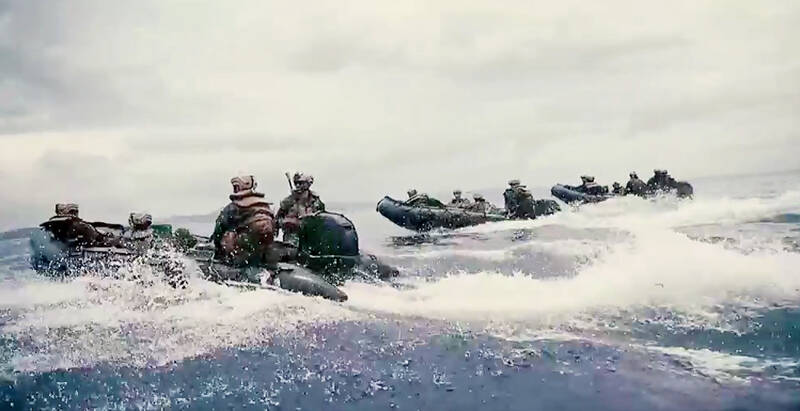The US Marine Corps and the Japan Ground Self-Defense Force have begun a military drill to simulate the retaking of outlying islands in Kyushu and Okinawa Prefecture in a conflict scenario, the Sankei Shimbun reported yesterday.
The drill, commonly known as “Iron Fist,” has been held in the US since 2006 before being moved to Japan for the first time this year, it said.
The large-scale operations are conducted with a possible “Taiwan emergency” in mind, aiming to keep China in check, it said.

Photo: Screen grab from video on US Marine Corps’ Web site
Unlike last year’s exercises, which focused on on-site training, this year’s maneuvers include strategy formulation and command for each unit by the Japanese and US headquarters, to bolster cooperation between higher-level departments, it said.
Scheduled to run until March 17, the militaries are to conduct landing drills on Okinoerabujima in Kagoshima Prefecture and the town of Kin in Okinawa, as well as F-35 stealth jet target practice on an uninhabited island west of Okinawa’s main island.
A Japanese Army settlement in Kumamoto Prefecture would be used as a maintenance base for helicopters, the report said.
About 600 members of the Japan Ground Self-Defense Force’s Amphibious Rapid Deployment Brigade are to land on and recapture occupied islands participating in the drill, it said.
The Japan Self-Defense Forces and the US military earlier this month conducted the highest-level military exercise, Keen Edge, in which a possible Taiwan contingency was set as the main scenario and China as a hypothetical enemy.
In other developments, the Chungshan Institute of Science and Technology is to conduct this year’s first tests of artillery and uncrewed aerial surveillance and reconnaissance vehicles at Jioupeng Military Base in Pingtung County’s Manjhou Township (滿州) next month, the Ministry of Transportation and Communications’ Maritime Port Bureau said.
The institute is to conduct the tests on five days — from Wednesday next week to Friday next week as well as March 13 and March 14 — during which the following areas would be under control: between Taitung County’s Taimali Township (太麻里) and Pingtung’s Majhou, as well as between the northwest of Orchid Island (Lanyu, 蘭嶼) and the south of Green Island, the bureau said in an announcement on Monday last week.
On Thursday and Friday next week, tests are to take place from 6am to 5pm and the sea areas are to be closed from midnight to early morning on both days, it said.
For the artillery tests, the bureau marked a danger zone of a minimum radius of 5 nautical miles (9.3km) and said that the maximum projectile altitude would be 7.62km.
For the uncrewed surveillance and reconnaissance aerial vehicles, the marked danger zone has a minimum radius of 12 nautical miles, possibly for conducting high-altitude reconnaissance operations.
The institute previously conducted missile tests in August and November last year.
While it was reported that Hsiung Feng II-E (雄風, “Brave Wind”) missiles were fired in August last year, the military has provided no further information regarding the tests, as well as next month’s tests.
Possible candidates include surface-to-air Tien Kung (天弓, “Sky Bow”) missiles, Wan Chien (萬劍, “Thousand Sword”) cluster-munition missiles and Yu Cha (魚叉, “Harpoon”) anti-ship missiles.

The US government has signed defense cooperation agreements with Japan and the Philippines to boost the deterrence capabilities of countries in the first island chain, a report by the National Security Bureau (NSB) showed. The main countries on the first island chain include the two nations and Taiwan. The bureau is to present the report at a meeting of the legislature’s Foreign Affairs and National Defense Committee tomorrow. The US military has deployed Typhon missile systems to Japan’s Yamaguchi Prefecture and Zambales province in the Philippines during their joint military exercises. It has also installed NMESIS anti-ship systems in Japan’s Okinawa

‘WIN-WIN’: The Philippines, and central and eastern European countries are important potential drone cooperation partners, Minister of Foreign Affairs Lin Chia-lung said Minister of Foreign Affairs Lin Chia-lung (林佳龍) in an interview published yesterday confirmed that there are joint ventures between Taiwan and Poland in the drone industry. Lin made the remark in an exclusive interview with the Chinese-language Liberty Times (the Taipei Times’ sister paper). The government-backed Taiwan Excellence Drone International Business Opportunities Alliance and the Polish Chamber of Unmanned Systems on Wednesday last week signed a memorandum of understanding in Poland to develop a “non-China” supply chain for drones and work together on key technologies. Asked if Taiwan prioritized Poland among central and eastern European countries in drone collaboration, Lin

BACK TO WORK? Prosecutors said they are considering filing an appeal, while the Hsinchu City Government said it has applied for Ann Kao’s reinstatement as mayor The High Court yesterday found suspended Hsinchu mayor Ann Kao (高虹安) not guilty of embezzling assistant fees, reducing her sentence to six months in prison commutable to a fine from seven years and four months. The verdict acquitted Kao of the corruption charge, but found her guilty of causing a public official to commit document forgery. The High Prosecutors’ Office said it is reviewing the ruling and considering whether to file an appeal. The Taipei District Court in July last year sentenced Kao to seven years and four months in prison, along with a four-year deprivation of civil rights, for contravening the Anti-Corruption

NO CONFIDENCE MOTION? The premier said that being toppled by the legislature for defending the Constitution would be a democratic badge of honor for him Premier Cho Jung-tai (卓榮泰) yesterday announced that the Cabinet would not countersign the amendments to the local revenue-sharing law passed by the Legislative Yuan last month. Cho said the decision not to countersign the amendments to the Act Governing the Allocation of Government Revenues and Expenditures (財政收支劃分法) was made in accordance with the Constitution. “The decision aims to safeguard our Constitution,” he said. The Constitution stipulates the president shall, in accordance with law, promulgate laws and issue mandates with the countersignature of the head of the Executive Yuan, or with the countersignatures of both the head of the Executive Yuan and ministers or